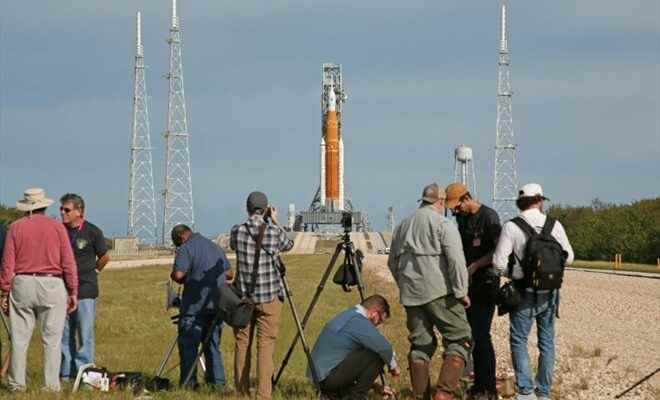The top of the SLS rocket for the Moon, on November 13, 2022 at the Kennedy Space Center in Florida, before its liftoff for the Artemis 1 mission (AFP/Jim WATSON)
Third test for NASA’s new mega-rocket: the takeoff of the Artemis 1 mission is scheduled for the night of Tuesday to Wednesday from Florida, and this time all the lights seem to be green to finally launch the great American program back on the moon.
The first flight of the SLS rocket, the most powerful in the world, is scheduled for Wednesday at 1:04 a.m. local time (06:04 GMT), with a possible launch window of two hours.
The weather promises to be cooperative, with a 90% chance of favorable weather.
“Our time will come, and we hope it will be Wednesday,” mission manager Mike Sarafin said Monday evening. He praised the “perseverance” of his teams, which had to bounce back after two failed take-off attempts this summer, then two hurricanes.
Fifty years after the last Apollo mission, this unmanned test flight, which will circumnavigate the Moon without landing there, should confirm that the vehicle is safe for a future crew. This same rocket will take the first woman and the first person of color to the Moon in the future.
Despite a night launch on Wednesday, some 100,000 people are expected to admire the show, especially from the surrounding beaches. Many astronauts are also making the trip, including the Frenchman Thomas Pesquet.
The complex refueling operations are due to begin Tuesday afternoon at the Kennedy Space Center, under the orders of Charlie Blackwell-Thompson, NASA’s first female launch director.
The orange-colored main stage of the rocket will be filled with no less than 2.7 million liters of liquid oxygen and hydrogen.

NASA’s Orion capsule (AFP/Gal ROMA)
This summer, a hydrogen leak caused the cancellation of the second take-off attempt at the last moment. The procedures have since been modified, and successfully verified in a test. The first cancellation was due to a faulty sensor.
NASA officials have repeatedly said that these problems are normal for a brand new vehicle, which its teams are learning to understand and handle.
– 25-day mission –
After these technical problems, two hurricanes successively threatened the rocket. This 98-meter-high giant first had to be returned to its assembly building at the end of September to be sheltered from Hurricane Ian, postponing take-off by several weeks.
Then, once out on her launch pad, she had to face the winds of Hurricane Nicole less than a week ago. This storm caused damage to a thin layer of sealant at the top of the rocket, but NASA estimated Monday that the risk induced was minimal.
In total, the program is several years behind schedule, and the success of this mission, which costs several billion dollars, has become imperative for NASA.
Right after takeoff, crews from the control center in Houston, Texas, will take over.
After two minutes, the two white boosters will fall back into the Atlantic. After eight minutes, the main stage will detach in turn. Then, around 1h30 after takeoff, a final push from the upper stage will put the Orion capsule on its way to the Moon, which it will reach in a few days.

Photographers in front of NASA’s SLS rocket on November 13, 2022 at the Kennedy Space Center in Florida (AFP/Gregg Newton)
There, it will be placed in a distant orbit for about a week, and will venture up to 64,000 km behind the Moon — a record for a habitable capsule.
Finally, Orion will begin its return to Earth, testing its heat shield, the largest ever built. It will have to withstand a temperature half as hot as the surface of the Sun as it passes through the atmosphere.
If the takeoff takes place on Wednesday, the mission should last 25 and a half days, with a landing in the Pacific Ocean on December 11.
– New era –
After the Saturn V rocket of the Apollo missions, then the space shuttles, SLS must bring NASA into a new era of human exploration – this time from deep space.
In 2024, Artemis 2 will take astronauts to the Moon, still without landing there. An honor reserved for the crew of Artemis 3, in 2025 at the earliest.
NASA then plans one mission per year, in particular to build a space station in orbit around the Moon, named Gateaway, and a base on its south pole.
The goal is to test new equipment there: space suits, pressurized vehicle, mini-power plant, use of the ice water present on site… All in order to establish a lasting human presence there.
This experiment should prepare a manned flight to Mars, perhaps at the end of the 2030s. The round trip will take at least two years.
© 2022 AFP
Did you like this article ? Share it with your friends with the buttons below.




